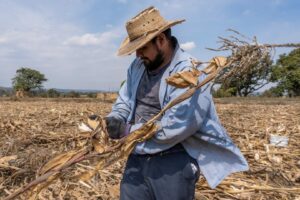
In Somalia, “hundreds of thousands are already facing starvation today with staggering levels of malnutrition expected among children under five,” warned the Food and Agriculture Organization (FAO) and the World Food Programme (WFP).
“Large-scale deaths from hunger” are increasingly likely in the east African nation, the UN agencies continued, noting that unless “adequate” help arrives, analysts expect that by December, “as many as four children or two adults per 10,000 people, will die every day”.
Complex roots
In addition to the emergency already unfolding in Somalia, the UN agencies flagged 18 more deeply concerning “hunger hotspots”, whose problems have been created by conflict, drought, economic uncertainty, the COVID pandemic and Russia’s invasion of Ukraine.
Humanitarians are particularly worried for Afghanistan, Ethiopia, South Sudan, Somalia, and Yemen, where a record 970,000 people “are expected to face catastrophic hunger and are starving or projected to starve or at risk of deterioration to catastrophic conditions, if no action is taken”, the UN agencies said.
This is 10 times more than six years ago, when only two countries had populations as badly food insecure, FAO and WFP noted, in a new report.
Urgent humanitarian action is needed and at scale in all of these at-risk countries “to save lives and livelihoods” and prevent famine, the UN agencies insisted.
Harsh winter harvest
According to FAO and WFP, acute food insecurity around the world will worsen from October to January.
In addition to Somalia, they highlighted that the problem was also dire in the wider Horn of Africa, where the longest drought in over 40 years is forecast to continue, pushing people “to the brink of starvation”.
Successive failed rains have destroyed people’s crops and killed their livestock “on which their survival depends”, said FAO Director-General QU Dongyu, who warned that “people in the poorest countries” were most at risk from acute food security that was “rising fast and spreading across the world”.
FAO’s QU calls for massive aid scale-up
Vulnerable communities “have yet to recover from the impact of the COVID-19 pandemic are suffering from the ripple effects of ongoing conflicts, in terms of prices, food and fertilizer supplies, as well as the climate emergency,” the FAO chief continued.

He insisted that “without a massively scaled-up humanitarian response” to sustain agriculture, “the situation will likely worsen in many countries in the coming months”.
Echoing that message, WFP Executive Director David Beasley appealed for immediate action to prevent people dying.
“We urgently need to get help to those in grave danger of starvation in Somalia and the world’s other hunger hotspots,” he said.
Perfect storm of problems
“This is the third time in 10 years that Somalia has been threatened with a devastating famine,” Mr. Beasley continued.
“The famine in 2011 was caused by two consecutive failed rainy seasons as well as conflict. Today we’re staring at a perfect storm: a likely fifth consecutive failed rainy season that will see drought lasting well into 2023.”
In addition to soaring food prices, those most at risk from acute food insecurity also have “severely limited opportunities” to earn a living because of the pandemic, the WFP chief explained, as relief teams brace for famine in the Somali districts of Baidoa and Burhakaba in Bay region, come October.
Below the “highest alert” countries – identified as Afghanistan, Ethiopia, Nigeria, South Sudan, Somalia and Yemen – the joint FAO-WFP report notes that the Democratic Republic of the Congo, Haiti, Kenya, the Sahel, the Sudan and Syria are “of very high concern”, in addition to newcomers the Central African Republic and Pakistan.
Guatemala, Honduras and Malawi have also been added to the list of hunger hotspot countries, joining Madagascar, Sri Lanka and Zimbabwe.
Barriers to aid
Humanitarian assistance is crucial to save lives and prevent starvation, death and the total collapse of livelihoods, FAO and WFP insist, while highlighting chronic access problems caused by “insecurity, administrative and bureaucratic impediments, movement restrictions and physical barriers” in 11 of the 19 hotspot countries.
This includes “all six of the countries where populations are facing or are projected to face starvation…or are at risk of deterioration towards catastrophic conditions”, they said.
Source: United Nations
















